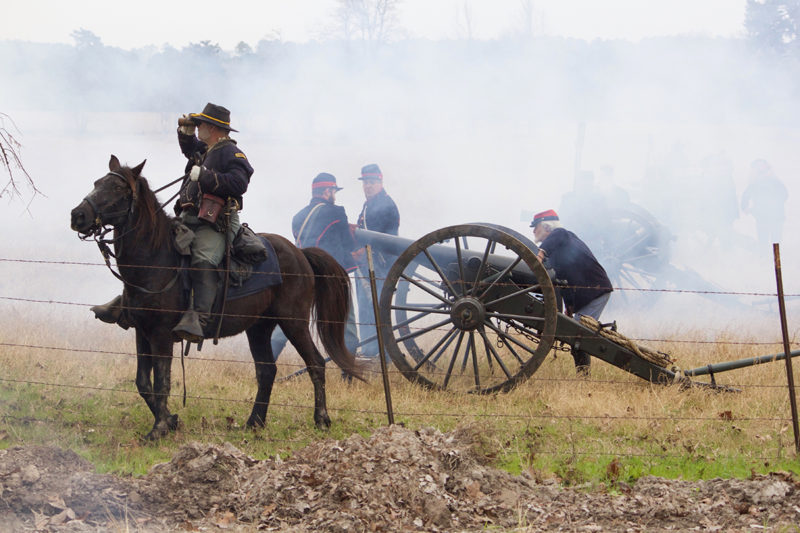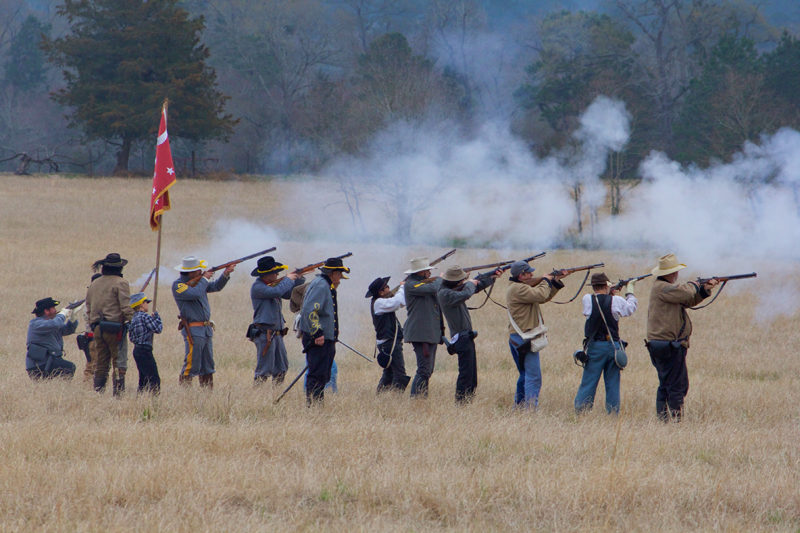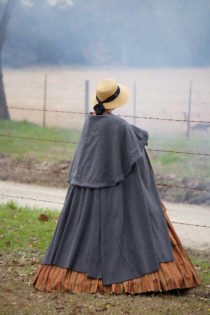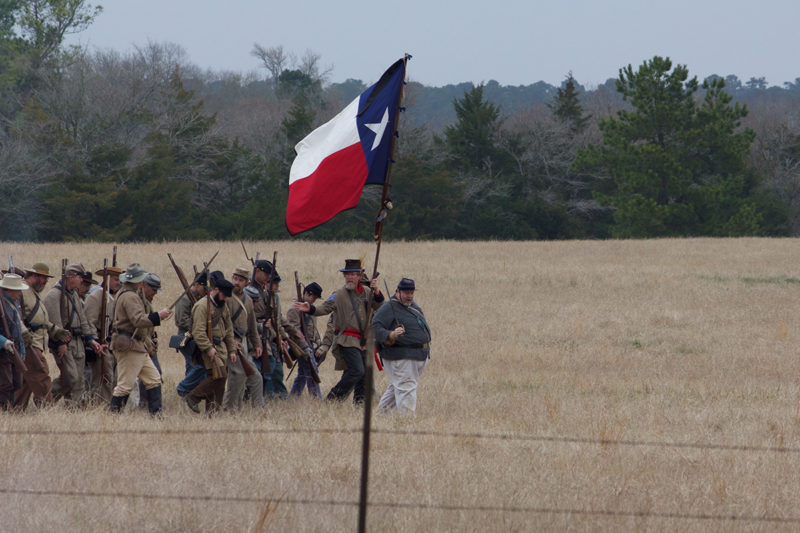Civil War Battle Rises Again in East Texas
By Andrea Tinning
Reporting Texas

Reenactors traveled from across the country to Groveton, in Trinity County, for the annual Battle of Blackjack Grove performance in February. Katie Duncan/Reporting Texas
GROVETON — On a Saturday in February, several dozen people, a handful wearing red “Make America Great Again” hats, descended on a field in this East Texas town of about 1,000 people to watch several dozen men stage a simulated Civil War battle. Confederate battle flags flapped in the wind, cannon blasts shook the earth and smoke created a ghostly atmosphere in the adjacent cemetery where spectators gathered to watch the battle.
The annual Battle of Blackjack Grove started in 2017 and has attracted more and more attendees each year, says Cheryl McMahon, the event chair for the Trinity County Chamber of Commerce, which organizes the battle. This year, more than 1,000 people attended the event, which takes places on the second weekend in February.
Happening amid a national debate about how to best remember the Confederacy, the event has been criticized by some East Texas residents who say it is racially insensitive. McMahon and participants say the simulated battle is simply an example of living history, a unique and invaluable opportunity to better understand the past.
Staging a mock Civil War battle that portrays the Confederate army — which fought to preserve slavery — as heroic sends a negative message to black people, says Billy “Hollywood” Groves, a black civil rights activist from the East Texas town of Crockett.
“When you look back, there really wasn’t nothing brave about [the Confederacy]. That was a rebellion,” Groves said. “And to me, that should always have scars on it.”
However, Texans such as Marshall Davis, a spokesperson for the Texas chapter of the Sons of Confederate Veterans, says the Civil War was as much about fighting an overreaching federal government as about preserving slavery.
“Any war that has been fought in the history of man has been fought to get somebody else’s land, or somebody else’s money, or somebody else’s power,” Davis said. “The War Between the States was a battle of who gets to run the South: the South or Washington, D.C.”
Kevin Levin, a Civil War historian and author of the forthcoming book “Searching For Black Confederates, The Civil War’s Most Persistent Myth,” says many people’s understanding of the Civil War doesn’t reflect a harsh truth — the Confederacy was fighting, first and foremost, to preserve slavery.

Reenactors dressed as soldiers fire muskets during the annual Battle of Blackjack Grove in February. Katie Duncan/Reporting Texas
Texas’ Ordinance of Secession, which separated Texas from the Union in 1861, declared that Texas seceded because non-slave-holding states “demand the abolition of negro slavery throughout the Confederacy.”
“[The Union and Confederacy] fought for their respective principles, but we’re not going to talk about what those principles were, we’re going to keep it at a level that allows the nation to unite. We’re not going to rock the boat,” Levin said. “That may have satisfied many white Americans. It allowed them to remember a war that was easily mythologized. It certainly left out many African Americans from that dominant narrative.”
The Battle of Blackjack Grove was conceived specifically as an educational tool, not as a part of the national culture-war fight over how to remember the Confederacy, McMahon says.
A few years ago, a drama teacher at Groveton High School recruited some friends to stage a battle to help students understand the setting of a Civil War-themed play they were performing. The teacher then approached McMahon to expand the event into a countywide celebration, which she did in 2017. Each year the event has been held, Trinity County students have attended.
In terms of historical accuracy, the Battle of Blackjack Grove is a work of fiction; no Civil War battle by that name was fought in Texas.
Donald Frazier, professor of history and chair of the history department at McMurry University in Abilene, said much of what is taught about the Civil War in schools across the U.S. is inaccurate because it mythologizes the Confederacy as having fought for heroic ideals. Some members of the Texas Education Board recognized this shortcoming in the fall of 2018 when they voted to change the state’s social studies curriculum standards to indicate that slavery played a “central role” in the Civil War. Previously slavery had been only listing as a contributing factor.

A woman dressed in Civil War-era attire watches the annual Battle of Blackjack Grove in February. Katie Duncan/Reporting Texas
Frazier has participated in Civil War battle reenactments, playing the role of both Union and Confederate soldiers. He sees historically accurate, scripted and correctly located reenactments as an auxiliary to his studies. However, he has found that most people he encounters at reenactments do not have the same interest in history as he does.
“Reenactors will tell you their motivation may be X, but if you ask them to put in the work to make that claim stick, I found them a little reluctant to do the hard and heavy lifting,” Frazier said. “I think that I have very rarely run into a serious student of the American Civil War on a reenacted battle. I’ve run into a lot of people that like themed camping, because that’s really what it is.”
The pushback against events and symbols honoring the Confederacy gained steam when a 19-year-old Confederate battle flag-waving white supremacist murdered nine black churchgoers in Charleston, South Carolina, in July 2015. Since then, at least 114 Confederate symbols have come down around the nation, according to a report from the Southern Poverty Law Center.
More monuments have come down in Texas — a total of at least 33— than any other state, according to the same report. In August 2017, several statues honoring prominent Confederates were moved from the campus of the University of Texas at Austin. The city of Dallas removed a multi-ton statue of Confederate General Robert E. Lee in September 2017, and in January, the State Preservation Board ordered the removal of a plaque from the Capitol that praised the Confederacy and incorrectly claimed slavery was not the cause of the Civil War.
Curt Locklear, a historical fiction author and a resident of The Woodlands, attended the Battle of Blackjack Grove. He says criticism of the event is misplaced and the backlash against Confederate monuments is un-American.
“(A) handful of people… are trying to hide history by tearing down the monuments,” Locklear said. “That’s the same thing Russians did when Communists took over. They tore down all the statues, they turned the churches into warehouses, and we don’t need to do that.”
The willingness to stage a Civil War battle in Trinity County does not surprise Phil Latham, a journalist in the East Texas town of Longview. Latham reported on a Ku Klux Klan rally in Groveton in the 1990s.
“That ought to be a big hit in Groveton,” he said in an email. “Maybe they’ll decide to reinstate slavery for the day.”

Reenactors march during the annual Battle of Blackjack Grove in February. Katie Duncan/Reporting Texas
Latham says event supporters are failing to see the event’s connection to the area’s history of racism. After the Civil War, the KKK conducted night rides in Trinity County to terrorize newly freed black people, according to the Texas State Historical Association. In 1910, the Slocum Massacre occurred in nearby Anderson County, where a mob of white men executed at least eight black citizens. More recently, in 2018, a yard display of a scarecrow dressed in a KKK hood and holding a Confederate flag caused controversy in Anderson County.
As for criticism that the battle is racially insensitive, McMahon says it’s misguided.
“Everybody in our community gets along pretty well,” McMahon said. “I can’t even imagine that [racial tension] would go on in our community because that just doesn’t happen.” Trinity County is about 90 percent white and 10 percent black, according to the U.S. Census Bureau.
Chris Hughes, a resident of the East Texas town of Lovelady, attended the battle with his family.
Hughes also doesn’t view the event as racially insensitive. He sees it as an excellent learning opportunity that he thinks will inspire a lifelong interest in the Civil War in his children.
“My kids, they had a fun experience,” Hughes said. “I know that my kids, when they get older, they’re going to go to a Civil War reenactment, just because of the experience that these men gave them.”